Wikipedia:Picture of the day/June 2005
|
Featured picture tools: |
These featured pictures, as scheduled below, appeared as the picture of the day (POTD) on the English Wikipedia's Main Page in June 2005.
You can add an automatically updating POTD template to your user page using {{Pic of the day}} (version with blurb) or {{POTD}} (version without blurb). For instructions on how to make custom POTD layouts, see Wikipedia:Picture of the day.Purge server cache
June 1
[edit]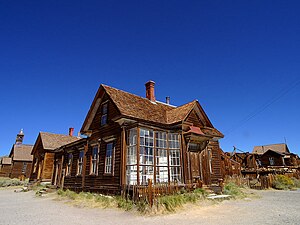
|
A ghost town is a town that has been abandoned, usually because the economic activity that supported it has failed or because of natural or human-caused disasters. Ghost towns are almost stereotypically common in mining areas, particularly the western United States following the Gold rushes of the 19th century, but similar derelict mining camps can be found in Canada, Australia and elsewhere. Photo credit: Jon Sullivan, PDphoto.org |
Text version ( view - edit - talk - history ) - Condensed version ( view - edit )
June 2
[edit]
|
Yellow rattle (Rhinanthus minor) is a flowering plant in the family Scrophulariaceae. This family comprises "220-300 genera and 4000-4500 species. The family has a cosmopolitan distribution, with the majority found in temperate areas, including tropical mountains. Other members of the family include Digitalis, Linaria and Verbascum. Yellow rattle is a semi-parasitic plant that gains some of its nutrients from the roots of neighbouring plants. The name refers to the seedpods, which contain loose, rattling seeds when ripe. Photo credit: Sannse |
Text version ( view - edit - talk - history ) - Condensed version ( view - edit )
June 3
[edit]
|
The Red-crested Pochard (Netta rufina) is a large diving duck. Their breeding habitat is lowland marshes and lakes in southern Europe and southern and central Asia. They are somewhat migratory, and northern birds winter further south and into north Africa. These birds feed mainly by diving or dabbling. They eat aquatic plants, and typically upend for food more than most diving ducks. Photo credit: PDphoto |
Text version ( view - edit - talk - history ) - Condensed version ( view - edit )
June 4
[edit]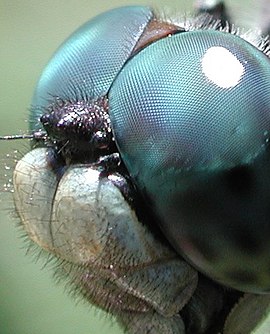
|
A compound eye is a visual organ found in certain arthropods. The compound eye consists of between 12 and 1,000 ommatidia, little dark/bright sensors. The image perceived by the arthropod is "recalculated" from the numerous ommatidia which point in slightly different directions. In contrast to other eye types, there is no central lens or retina. Though the resulting image is poor in resolution, it can detect quick movements and, in some cases, the polarization of light. Dragonflies have about 30,000 facets to their compound eyes, giving them nearly a 360° field of vision. Photo credit: David L. Green |
Text version ( view - edit - talk - history ) - Condensed version ( view - edit )
June 5
[edit]
|
The first photograph is considered to be this image produced in 1826 by the French inventor Nicéphore Niépce on a polished pewter plate covered with a petroleum derivative called bitumen of Judea. It was produced with a camera, and required an eight hour exposure in bright sunshine. However this process turned out to be a dead end and Niépce subsequently began experimenting with silver compounds based on a process discovered by Johann Heinrich Schultz in 1724. Photo credit: Nicéphore Niépce (1826) |
Text version ( view - edit - talk - history ) - Condensed version ( view - edit )
June 6
[edit]
|
Mars, the fourth planet from the Sun, is named after the Roman god of war because of its blood red color. Mars has two small, oddly-shaped moons, Phobos and Deimos, named after the sons of the Greek god Ares. At some point in the future Phobos will be broken up by gravitational forces. The atmosphere on Mars is 95% carbon dioxide. In 2003 methane was also discovered in the atmosphere. Since methane is an unstable gas, this indicates that there must be (or have been within the last few hundred years) a source of the gas on the planet. Photo credit: NASA |
Text version ( view - edit - talk - history ) - Condensed version ( view - edit )
June 7
[edit]
|
A test firing of twin linear XRS-2200 Aerospike engines. The aerospike engine is a type of rocket engine that maintains its efficiency across a wide range of altitudes through the use of an aerospike nozzle. A standard rocket engine uses a bell shaped nozzle to contain and direct the exhaust gases. However the optimum shape of the bell depends on the air pressure, which decreases as the rocket climbs. An aerospike uses the air flowing past the rocket to form half of a 'virtual bell' which automatically compensates for the reducing pressure. Photo credit: NASA, Marshall Space Flight Center |
Text version ( view - edit - talk - history ) - Condensed version ( view - edit )
June 8
[edit]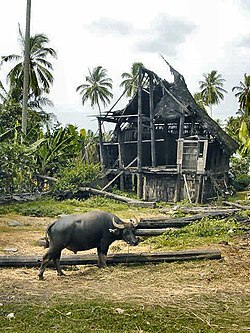
|
The Water Buffalo is a very large ungulate. It probably survives in the wild in India, Nepal, Bhutan and Thailand; is very widespread as a domestic animal in Asia, South America. North Africa and Europe; and is feral in northern Australia. Wild-living populations of Water Buffalo also exist in much of South-east Asia but their origin is uncertain: they may be the descendants of wild Water Buffalo, formerly domesticated ferals, or a mixture of both. The population of wild Water Buffalo has become very sparse. Photo credit: Chmouel Boudjnah |
Text version ( view - edit - talk - history ) - Condensed version ( view - edit )
June 9
[edit]
|
A rope trick is the whimsical term given by physicist Dr. John Malik to the curious lines and spikes which emanate from the fireball of a nuclear explosion just after detonation. The image is from the Tumbler-Snapper test series of 1952. The surface of the fireball is over 20,000 kelvins and emits huge amounts of visible light radiation. The 'rope tricks' which protrude from the bottom of the fireball are caused by the heating, rapid vaporization and then expansion of the mooring cables tethering the tower supporting the nuclear bomb at the start of the test. Photo credit: Lawrence Livermore National Laboratory |
Text version ( view - edit - talk - history ) - Condensed version ( view - edit )
June 10
[edit]
|
Women dressed as geisha in Kyoto, Japan. They are wearing traditional kimonos and geta. Geisha (芸者) are traditional Japanese artist-entertainers. Geisha were very common in the 18th and 19th centuries, and are still in existence today, although their numbers are dwindling. The geisha tradition evolved from the taikomochi or hōkan, similar to court jesters. Geisha were traditionally trained from young childhood although modern geisha begin their training, which remains extremely long and difficult, at much older age. Photo credit: Michael Reeve |
Text version ( view - edit - talk - history ) - Condensed version ( view - edit )
June 11
[edit]
|
Bronc riding is a rodeo sport that involves a rider getting on an untamed horse or bronco, held in a small pipe enclosure, and attempting to stay on the horse's back as the horse is released into the arena. The rider tightly grips a handle which is strapped to the horse, and the untamed horse naturally tries to throw or buck off the rider. Horses, being prey animals, do not care to have things on their backs. The rider must stay on the horse for 8 seconds without touching the horse with his free hand. Photo credit: Erwin E. Smith (1909) |
Text version ( view - edit - talk - history ) - Condensed version ( view - edit )
June 12
[edit]
|
The four-stroke cycle of an internal combustion engine is the cycle most commonly used for automotive and industrial purposes today, including cars, trucks, and generators. The cycle was invented by Nikolaus Otto in 1876, and is also called the Otto cycle. The cycle is characterized by four strokes, or straight movements in a single direction, of the piston. Image credit: Eric Pierce |
Text version ( view - edit - talk - history ) - Condensed version ( view - edit )
June 13
[edit]
|
Greencastle, Donegal is a commercial fishing port in County Donegal in the northwest of Ireland. The first proper pier was built in 1813 and has been added to several times since. Today, as well as being a tie up for trawlers and salmon boats, it is the home of the Greencastle Fishermen's Co-Op. This painting of the harbour, is by local artist Sheila McClean. Photo credit: Sean McClean |
Text version ( view - edit - talk - history ) - Condensed version ( view - edit )
June 14
[edit]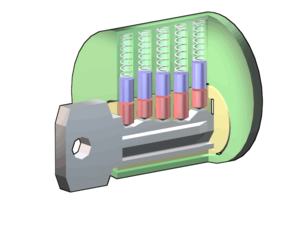
|
The pin tumbler lock is a lock mechanism that utilizes a group of pins of varying lengths to prevent opening the lock without the correct key. Pin tumblers are most commonly employed in cylinder locks, but may also be found in tubular or radial locks. When the correct key is inserted, the gaps between the key pins (red) and driver pins (blue) align with the edge of the plug (yellow). Illustration credit: Eric Pierce |
Text version ( view - edit - talk - history ) - Condensed version ( view - edit )
June 15
[edit]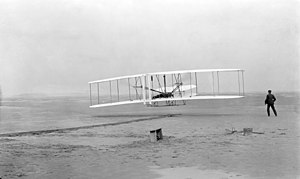
|
The Wright Flyer was the first powered aircraft designed and built by the Wright Brothers in 1903. It is generally considered to be the first successful powered, piloted aircraft. In this photograph of the first flight at Kitty Hawk, North Carolina, Orville Wright is at the controls, lying prone on the lower wing with hips in the cradle that operated the wing warping mechanism. Wilbur Wright running alongside, has just released his hold to balance the machine. Photo credit: John T. Daniels (1903) |
Text version ( view - edit - talk - history ) - Condensed version ( view - edit )
June 16
[edit]
|
Tawaret was a popular deity in ancient Egyptian mythology. She was a household deity who protected women during pregnancy and childbirth, in conjunction with another deity, Bes. Tawaret was depicted as an amalgam of human and animal with the head of a hippopotamus,the arms and legs of a lion, the back and tail of a crocodile, and the breasts and stomach of a pregnant woman. Photo credit: ChrisO |
Text version ( view - edit - talk - history ) - Condensed version ( view - edit )
June 17
[edit]
|
Predation is an interaction between organisms (animals) in which one organism captures and feeds upon another called the prey. Although predation most often refers to carnivory, in ecology it can also include many other types of feeding behaviors including parasitism, parasitoidism, and herbivory. Photo credit: Fir0002 |
Text version ( view - edit - talk - history ) - Condensed version ( view - edit )
June 18
[edit]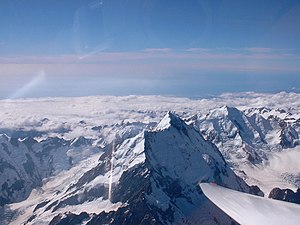
|
Mount Cook, a peak in the Southern Alps is the highest mountain in New Zealand. Mount Cook is also known as Aoraki, meaning "Cloud Piercer" in the Kai Tahu dialect of the Maori language. The mountain is located within the Aoraki/Mount Cook National Park and was formally declared one of the United Nations World Heritage Parks in 1953. Photo credit: Dynabee |
Text version ( view - edit - talk - history ) - Condensed version ( view - edit )
June 19
[edit]
|
Relief map showing the varying age of bedrock underlying North America. This cartographic tapestry is woven from a geologic map and a shaded relief image. This combination reveals the geologic history of North America through the interrelation of rock type, topography and time. Regional surface processes as well as continent-scale tectonic events are exposed in the three dimensions of space and the fourth dimension, geologic time. Image credit: USGS, GSC & MCRM |
Text version ( view - edit - talk - history ) - Condensed version ( view - edit )
June 20
[edit]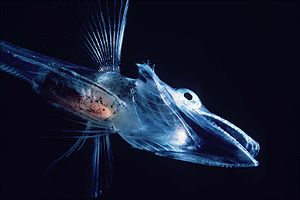
|
Icefish are a type of Antarctic fish belonging to various families, including the Channichthyidae family. They have no haemoglobin and their blood is transparent. They feed on krill, copepods, and other fish. Icefish rely on well-oxygenated water and absorb oxygen directly through the skin as they lack red blood cells. Photo credit: Uwe Kils |
Text version ( view - edit - talk - history ) - Condensed version ( view - edit )
June 21
[edit]
|
Albert Einstein was a German theoretical physicist who is widely regarded as the greatest scientist of the 20th century. He proposed the theory of relativity and also made major contributions to the development of quantum mechanics, statistical mechanics, and cosmology. He was awarded the 1921 Nobel Prize for Physics for his explanation of the photoelectric effect and "for his services to Theoretical Physics". Photo credit: Yousuf Karsh |
Text version ( view - edit - talk - history ) - Condensed version ( view - edit )
June 22
[edit]
| |
| The Skyline Boulevard in the San Francisco Bay Area stretches through the Santa Cruz Mountains, here near Palo Alto, California. Three large cities dominate the San Francisco Bay Area; San Francisco, San Jose, and Oakland. As well as constituting one of the world's greatest metropolitan areas, the Bay Area includes some exceptional natural coastal and rural landscape. It includes significant national parks such as the Point Reyes National Seashore and a large number of state parks.
Photo credit: Jawed Karim | |
Text version ( view - edit - talk - history ) - Condensed version ( view - edit )
June 23
[edit]
|
An arching fountain of Pahoehoe, approximately 10 m high, issuing from a spatter cone of Pu‘u Kahaualea, Hawaii. Lava, when first exuded from a volcanic vent, is a liquid at very high temperature: typically from 700°C to 1200°C. Although, the viscosity of lava is 100,000 times that of water, the viscous rock can flow many miles before eventually cooling and solidifying. Photo credit: J.D. Griggs, USGS |
Text version ( view - edit - talk - history ) - Condensed version ( view - edit )
June 24
[edit]
|
Darlingtonia (Darlingtonia californica), also called the California Pitcher plant or Cobra Lily, is a carnivorous plant in the family Sarraceniaceae. Darlingtonia is native to California and Oregon and grows in bogs and seeps. The name Cobra Lily is from the resemblance of the tubular leaf to a rearing Cobra, complete with "fangs". The genus Darlingtonia is monotypic. Photo credit: Daniel Keshet |
Text version ( view - edit - talk - history ) - Condensed version ( view - edit )
June 25
[edit]
|
The atmosphere of Jupiter as seen from Voyager 1, including the anticyclonic storm known as the Great Red Spot. Jupiter's atmosphere is composed of ~81% hydrogen and ~18% helium with ~1% of other substances. This atmospheric composition is very close to the composition of the solar nebula. Saturn has a similar composition, but Uranus and Neptune have much less hydrogen and helium. The Earth's atmosphere is quite different, being primarily composed of nitrogen. Photo credit: Atmosphere of Jupiter |
Text version ( view - edit - talk - history ) - Condensed version ( view - edit )
June 26
[edit]
|
Weather lore, the informal folklore related to the prediction of the weather, suggests that the cumulus humilis clouds in this sky indicate a good day ahead. Such clouds show there is very little convection in the lower atmosphere, and the fact that it is well-formed indicates light winds at low levels. There is no cloud aloft, and thus no moisture or stable conditions or both. The cumulus congestus on the horizon suggests showers may be possible three or four hours from now, at the earliest, but chances are good it will remain a pleasant day through until the evening. Photo credit: Denni Windrim |
Text version ( view - edit - talk - history ) - Condensed version ( view - edit )
June 27
[edit]
|
A piece of Aerogel supporting a 2.5 kg brick. Aerogel is a silicon-based substance and the world's lowest-density solid. It is composed of 99.8% air and is a stiff foam with a typical density of 3 mg per cm3. Aerogel holds 15 records for material properties, including best insulator and lowest-density solid. Aerogel can support 2000 times its own weight without collapsing. Photo credit: NASA |
Text version ( view - edit - talk - history ) - Condensed version ( view - edit )
June 28
[edit]
|
The National Gallery, London at night, illuminated for an event to promote the launch of a Pepsi commercial. The National Gallery, on the north side of Trafalgar Square, is an art gallery designed by William Wilkins. It holds part of the National Collection, particularly Western European art from 1250 to 1900. The collection of 2300 paintings belongs to the British public. Photo credit: Michael Reeve |
Text version ( view - edit - talk - history ) - Condensed version ( view - edit )
June 29
[edit]
|
The Nuremberg rally (officially, Reichsparteitag, literally "imperial party congress") was the annual rally of the National Socialist German Workers' Party during many of the years of Nazi rule in Germany. The Reichsparteitage were held annually in Nuremberg from 1934 to 1938 and are thus usually referred to in English as the Nuremberg rallies. The 1934 rally was caught on film by Leni Riefenstahl as a propaganda piece called Triumph of the Will. Photo credit: Unknown |
Text version ( view - edit - talk - history ) - Condensed version ( view - edit )
June 30
[edit]
|
Yellowstone National Park is a United States National Park located in the states of Idaho, Montana, and Wyoming. Yellowstone is the first and oldest national park in the world. The park is famous for its geothermal features and is home to grizzly bears, wolves, bison and elk. Photo credit: Daniel Mayer |
Text version ( view - edit - talk - history ) - Condensed version ( view - edit )
Picture of the day archives and future dates
